[English] 日本語
 Yorodumi
Yorodumi- PDB-6ly5: Organization and energy transfer in a huge diatom PSI-FCPI superc... -
+ Open data
Open data
- Basic information
Basic information
| Entry | Database: PDB / ID: 6ly5 | ||||||||||||||||||
|---|---|---|---|---|---|---|---|---|---|---|---|---|---|---|---|---|---|---|---|
| Title | Organization and energy transfer in a huge diatom PSI-FCPI supercomplex | ||||||||||||||||||
 Components Components |
| ||||||||||||||||||
 Keywords Keywords | PHOTOSYNTHESIS / diatom / PSI-FCPI / photosysyem | ||||||||||||||||||
| Function / homology |  Function and homology information Function and homology informationlight-harvesting complex / photosynthesis, light harvesting in photosystem I / chloroplast thylakoid lumen / photosynthesis, light harvesting / photosystem I reaction center / photosystem I / photosynthetic electron transport in photosystem I / photosystem I / photosystem II / plastid ...light-harvesting complex / photosynthesis, light harvesting in photosystem I / chloroplast thylakoid lumen / photosynthesis, light harvesting / photosystem I reaction center / photosystem I / photosynthetic electron transport in photosystem I / photosystem I / photosystem II / plastid / chlorophyll binding / chloroplast thylakoid membrane / response to light stimulus / photosynthesis / chloroplast / phosphoprotein binding / 4 iron, 4 sulfur cluster binding / oxidoreductase activity / electron transfer activity / metal ion binding / identical protein binding / membrane Similarity search - Function | ||||||||||||||||||
| Biological species |  Chaetoceros gracilis (Diatom) Chaetoceros gracilis (Diatom) | ||||||||||||||||||
| Method | ELECTRON MICROSCOPY / single particle reconstruction / cryo EM / Resolution: 2.38 Å | ||||||||||||||||||
 Authors Authors | Xiong, P. / Caizhe, X. | ||||||||||||||||||
 Citation Citation |  Journal: Nat Commun / Year: 2020 Journal: Nat Commun / Year: 2020Title: Structural basis for energy transfer in a huge diatom PSI-FCPI supercomplex. Authors: Caizhe Xu / Xiong Pi / Yawen Huang / Guangye Han / Xiaobo Chen / Xiaochun Qin / Guoqiang Huang / Songhao Zhao / Yanyan Yang / Tingyun Kuang / Wenda Wang / Sen-Fang Sui / Jian-Ren Shen /   Abstract: Diatom is an important group of marine algae and contributes to around 20% of the global photosynthetic carbon fixation. Photosystem I (PSI) of diatoms is associated with a large number of ...Diatom is an important group of marine algae and contributes to around 20% of the global photosynthetic carbon fixation. Photosystem I (PSI) of diatoms is associated with a large number of fucoxanthin-chlorophyll a/c proteins (FCPIs). We report the structure of PSI-FCPI from a diatom Chaetoceros gracilis at 2.38 Å resolution by single-particle cryo-electron microscopy. PSI-FCPI is a monomeric supercomplex consisting of 12 core and 24 antenna subunits (FCPIs), and 326 chlorophylls a, 34 chlorophylls c, 102 fucoxanthins, 35 diadinoxanthins, 18 β-carotenes and some electron transfer cofactors. Two subunits designated PsaR and PsaS were found in the core, whereas several subunits were lost. The large number of pigments constitute a unique and huge network ensuring efficient energy harvesting, transfer and dissipation. These results provide a firm structural basis for unraveling the mechanisms of light-energy harvesting, transfer and quenching in the diatom PSI-FCPI, and also important clues to evolutionary changes of PSI-LHCI. | ||||||||||||||||||
| History |
|
- Structure visualization
Structure visualization
| Movie |
 Movie viewer Movie viewer |
|---|---|
| Structure viewer | Molecule:  Molmil Molmil Jmol/JSmol Jmol/JSmol |
- Downloads & links
Downloads & links
- Download
Download
| PDBx/mmCIF format |  6ly5.cif.gz 6ly5.cif.gz | 1.7 MB | Display |  PDBx/mmCIF format PDBx/mmCIF format |
|---|---|---|---|---|
| PDB format |  pdb6ly5.ent.gz pdb6ly5.ent.gz | 1.6 MB | Display |  PDB format PDB format |
| PDBx/mmJSON format |  6ly5.json.gz 6ly5.json.gz | Tree view |  PDBx/mmJSON format PDBx/mmJSON format | |
| Others |  Other downloads Other downloads |
-Validation report
| Summary document |  6ly5_validation.pdf.gz 6ly5_validation.pdf.gz | 27.5 MB | Display |  wwPDB validaton report wwPDB validaton report |
|---|---|---|---|---|
| Full document |  6ly5_full_validation.pdf.gz 6ly5_full_validation.pdf.gz | 29.4 MB | Display | |
| Data in XML |  6ly5_validation.xml.gz 6ly5_validation.xml.gz | 556.9 KB | Display | |
| Data in CIF |  6ly5_validation.cif.gz 6ly5_validation.cif.gz | 628.4 KB | Display | |
| Arichive directory |  https://data.pdbj.org/pub/pdb/validation_reports/ly/6ly5 https://data.pdbj.org/pub/pdb/validation_reports/ly/6ly5 ftp://data.pdbj.org/pub/pdb/validation_reports/ly/6ly5 ftp://data.pdbj.org/pub/pdb/validation_reports/ly/6ly5 | HTTPS FTP |
-Related structure data
| Related structure data |  30012MC M: map data used to model this data C: citing same article ( |
|---|---|
| Similar structure data |
- Links
Links
- Assembly
Assembly
| Deposited unit | 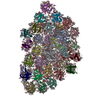
|
|---|---|
| 1 |
|
- Components
Components
+Protein , 30 types, 33 molecules ABCDEFGHIJKLMNOPQRSTWXabcdeflg...
-Protein/peptide , 3 types, 3 molecules ijm
| #26: Protein/peptide | Mass: 4474.527 Da / Num. of mol.: 1 / Source method: isolated from a natural source / Source: (natural)  Chaetoceros gracilis (Diatom) / References: UniProt: P17227*PLUS Chaetoceros gracilis (Diatom) / References: UniProt: P17227*PLUS |
|---|---|
| #27: Protein/peptide | Mass: 4733.593 Da / Num. of mol.: 1 / Source method: isolated from a natural source / Source: (natural)  Chaetoceros gracilis (Diatom) / References: UniProt: A4GGC6*PLUS Chaetoceros gracilis (Diatom) / References: UniProt: A4GGC6*PLUS |
| #29: Protein/peptide | Mass: 3139.878 Da / Num. of mol.: 1 / Source method: isolated from a natural source / Source: (natural)  Chaetoceros gracilis (Diatom) / References: UniProt: Q85G73*PLUS Chaetoceros gracilis (Diatom) / References: UniProt: Q85G73*PLUS |
-Sugars , 2 types, 29 molecules 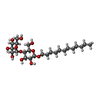


| #39: Sugar | ChemComp-LMT / #40: Sugar | |
|---|
-Non-polymers , 11 types, 713 molecules 
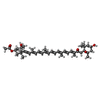

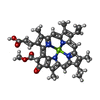



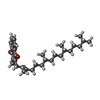













| #34: Chemical | ChemComp-DD6 / ( #35: Chemical | ChemComp-A86 / ( #36: Chemical | ChemComp-CLA / #37: Chemical | ChemComp-KC1 / #38: Chemical | #41: Chemical | ChemComp-LHG / #42: Chemical | ChemComp-LMG / #43: Chemical | #44: Chemical | ChemComp-BCR / #45: Chemical | #46: Water | ChemComp-HOH / | |
|---|
-Details
| Has ligand of interest | Y |
|---|---|
| Has protein modification | Y |
-Experimental details
-Experiment
| Experiment | Method: ELECTRON MICROSCOPY |
|---|---|
| EM experiment | Aggregation state: PARTICLE / 3D reconstruction method: single particle reconstruction |
- Sample preparation
Sample preparation
| Component | Name: a huge diatom PSI-FCPI supercomplex / Type: COMPLEX / Entity ID: #1-#33 / Source: NATURAL |
|---|---|
| Source (natural) | Organism:  Chaetoceros gracilis (Diatom) Chaetoceros gracilis (Diatom) |
| Buffer solution | pH: 6 |
| Specimen | Embedding applied: NO / Shadowing applied: NO / Staining applied: NO / Vitrification applied: YES |
| Vitrification | Cryogen name: ETHANE |
- Electron microscopy imaging
Electron microscopy imaging
| Experimental equipment |  Model: Titan Krios / Image courtesy: FEI Company |
|---|---|
| Microscopy | Model: FEI TITAN KRIOS |
| Electron gun | Electron source:  FIELD EMISSION GUN / Accelerating voltage: 300 kV / Illumination mode: FLOOD BEAM FIELD EMISSION GUN / Accelerating voltage: 300 kV / Illumination mode: FLOOD BEAM |
| Electron lens | Mode: BRIGHT FIELD |
| Image recording | Electron dose: 50 e/Å2 / Film or detector model: GATAN K2 SUMMIT (4k x 4k) |
- Processing
Processing
| EM software | Name: RELION / Version: 3 / Category: 3D reconstruction |
|---|---|
| CTF correction | Type: PHASE FLIPPING AND AMPLITUDE CORRECTION |
| Particle selection | Num. of particles selected: 891804 |
| Symmetry | Point symmetry: C1 (asymmetric) |
| 3D reconstruction | Resolution: 2.38 Å / Resolution method: FSC 0.143 CUT-OFF / Num. of particles: 164480 / Symmetry type: POINT |
 Movie
Movie Controller
Controller




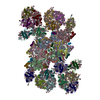
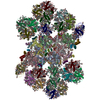
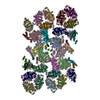

 PDBj
PDBj





















